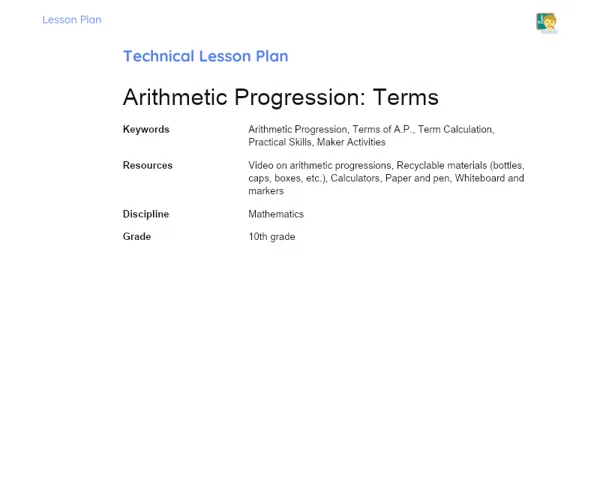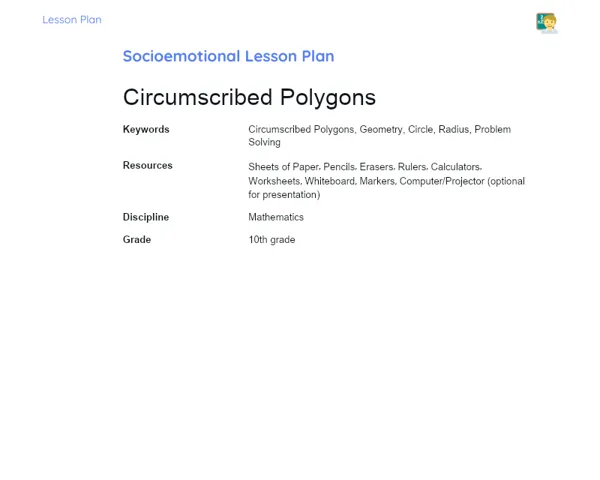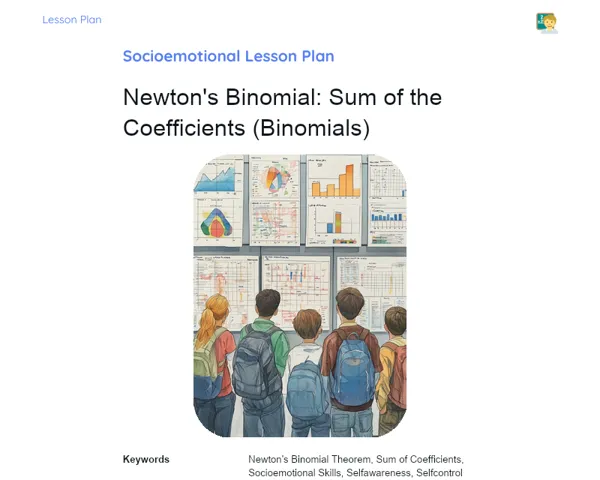Lesson Plan | Socioemotional Learning | Area and Perimeter: Comparison
| Keywords | Self-awareness, Self-control, Responsible Decision-Making, Social Skills, Social Awareness, Area, Perimeter, Mathematics, Geometric Shapes, Square, Rectangle, Triangle, Guided Meditation, RULER, Emotions, Emotional Intelligence, Socio-emotional Skills, Collaboration, Reflection, Emotional Regulation |
| Resources | Sheets of paper, Pencils, Erasers, Ruler, Sheets with geometric shapes and their measurements, Colored pens, Whiteboard, Markers, Clock or timer |
| Codes | - |
| Grade | 5th grade |
| Discipline | Mathematics |
Objective
Duration: (10 - 15 minutes)
This stage clearly outlines the lesson objectives, helping students understand what they'll be learning and how it connects to their socio-emotional development. By going through these objectives, the teacher sets the right mental and emotional tone, making the classroom environment more focused and engaging.
Objective Utama
1. Work out the areas and perimeters of basic shapes like squares, rectangles, and triangles.
2. Realise that shapes with the same perimeter can have different areas.
3. Enhance socio-emotional skills such as self-awareness and self-control while solving math problems.
Introduction
Duration: (15 - 20 minutes)
Emotional Warmup Activity
Guided Meditation for Focus and Concentration
For our emotional warm-up, we have chosen a session of Guided Meditation. Much like a simple yoga practice, this meditation involves following a series of calming instructions to relax and centre the mind. It’s an effective way to enhance focus, presence, and concentration, while also reducing stress and boosting self-awareness before the lesson begins.
1. Ask the students to sit comfortably in their chairs, keeping their feet flat on the floor and hands resting on their laps.
2. Instruct them to close their eyes and take deep breaths, inhaling through the nose and exhaling through the mouth for three cycles.
3. Guide their attention to the natural rhythm of their breathing, feeling each inhale and exhale.
4. Invite the students to imagine a peaceful place where they feel completely at ease – it could be a quiet beach, a lush field, or a serene garden.
5. Encourage them to visualise the details of this calming place, including the colours, sounds, and fragrances, to create a strong mental image.
6. Ask them to choose a word or phrase that represents calmness and focus, like 'serenity' or 'I am here now', and repeat it silently with every breath.
7. Continue this exercise for about five minutes.
8. Slowly bring the class back to the present by asking them to wiggle their fingers and toes.
9. Finally, have them open their eyes and take a deep, steadying breath as they prepare for the next activity.
Content Contextualization
Mathematics is a part of our day-to-day lives – whether we are planning room layouts, building houses, or even arranging a garden. Knowing how to calculate areas and perimeters is not only practical for tasks like estimating the amount of paint for a wall or the materials needed for a boundary, but it also sharpens our critical thinking and decision-making skills. Recognising that two shapes with the same perimeter might enclose different areas teaches students to look at problems from different angles, a skill that is useful both in maths and in everyday life. This understanding also encourages social awareness and teamwork, which are very important when tackling problems together.
Development
Duration: (60 - 75 minutes)
Theory Guide
Duration: (20 - 25 minutes)
1. Basic Definitions:
2. Perimeter: The total length around a geometric shape.
3. Area: The extent of a surface within the boundaries of a shape.
4. Calculating Perimeter:
5. Square: Perimeter = 4 x side.
6. Rectangle: Perimeter = 2 x (length + width).
7. Triangle: Perimeter = the sum of its three sides.
8. Calculating Area:
9. Square: Area = side x side.
10. Rectangle: Area = length x width.
11. Triangle: Area = (base x height) / 2.
12. Practical Examples:
13. Example 1: A square with each side measuring 4 cm has a perimeter of 16 cm and an area of 16 cm².
14. Example 2: A rectangle with a length of 5 cm and a width of 3 cm results in a perimeter of 16 cm and an area of 15 cm².
15. Example 3: A triangle with a base of 6 cm and a height of 4 cm has an area of 12 cm².
16. Comparison of Shapes:
17. Even if two shapes have the same perimeter, they might cover different areas. For instance, a square with 4 cm sides and a rectangle measuring 5 cm x 3 cm both have a perimeter of 16 cm, but their areas differ (16 cm² vs 15 cm²).
18. This comparison is designed to boost students' analytical and critical thinking abilities.
Activity with Socioemotional Feedback
Duration: (35 - 40 minutes)
Calculating Area and Perimeter with a Touch of Emotions
In this activity, students will form small groups to compute areas and perimeters of various shapes and then share their feelings experienced during the process. The aim is to build both mathematical skills and socio-emotional understanding.
1. Divide the class into groups of 3 to 4 students.
2. Give each group a sheet with various geometric shapes (squares, rectangles, and triangles) along with their dimensions.
3. Instruct them to calculate the perimeter and area for each given shape.
4. Ask the groups to document their answers and compare the different results.
5. Once the calculations are done, encourage a discussion on how they felt during the exercise – whether it was a feeling of confidence, a bit of anxiety, or calmness.
6. Have each group share both their mathematical findings and their emotional responses with the rest of the class.
Discussion and Group Feedback
After the practical work, arrange the students in a circle for a discussion using the RULER strategy:
Recognise: Ask the students to share the emotions they experienced during the activity. Did they feel confident, frustrated, or perhaps curious? Understand: Discuss what caused those feelings. Was it the challenge of the problem, group work dynamics, or something else? Label: Encourage them to name their emotions using varied vocabulary, such as excitement, anxiety, or satisfaction. Express: Let them talk about how they expressed their feelings – whether they sought help, supported their peers, or remained quiet. Regulate: Talk over ways to manage these emotions in future tasks, so that they can stay calm and confident when facing similar challenges.
This method helps students develop emotional intelligence and learn from their experiences, making the classroom a supportive and collaborative space.
Conclusion
Duration: (20 - 25 minutes)
Reflection and Emotional Regulation
Pair up or group the students in threes and ask them to discuss and jot down the challenges they faced during the lesson, especially when calculating the areas and perimeters. They should also reflect on how they managed their emotions during these tasks and the strategies they employed to remain calm and focused. This reflection can then be shared within the group or with the whole class to encourage mutual learning and support.
Objective: This activity aims to help students practice self-reflection and emotional management, enabling them to identify effective ways of handling difficult situations. By discussing their experiences, they build self-awareness and learn how to express and control their emotions, which is crucial for both personal growth and academic success.
Glimpse into the Future
Explain to the students that setting both personal and academic goals is key to continual improvement. Ask each student to note down one personal and one academic goal related to what they learned today. Depending on time, these goals can be shared in small groups or with the entire class.
Penetapan Objective:
1. Personal Goal: Improve the ability to manage stress during challenging activities.
2. Academic Goal: Keep practising calculations of areas and perimeters until proficient.
3. Academic Goal: Use the concepts of area and perimeter in solving everyday practical problems.
4. Personal Goal: Develop better strategies for effective teamwork in group tasks. Objective: This section is meant to encourage student autonomy and the practical application of their knowledge, thereby supporting ongoing academic and personal development. Setting these goals helps students to focus on their progress in both mathematical skills and socio-emotional competence.



